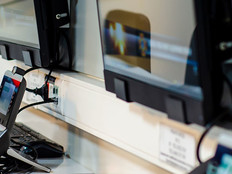How Police Fight Crime with Mobile Apps and Social Media
When it comes to using mobile apps and social media tools such as Facebook and Twitter, police departments are on the case.
Public safety agencies around the country aim to reach the public where they live today — on their notebooks, tablets and smartphones. New technology also helps police streamline antiquated, paper-based administrative processes.
Take the Syracuse Police Department in New York, which last September deployed an application from Coplogic that lets citizens use mobile devices to report routine thefts and criminal mischief cases and receive a PDF copy via e-mail.
"The technology really helps us improve our service and makes it more convenient for the citizens," says Sgt. Patrick Phelps, a supervisor for the Syracuse Police Department's Technology Division. "In the past, it could take up to a month to get an official copy of a police report."
"The system gives us the ability to be proactive."
Sgt. Patrick Phelps, Syracuse Police Department
Phelps describes an arcane process in which a crime victim would call the department and leave a message reporting a crime, an officer would phone back to verify the claim and then mail a paper form for the person to complete and return. Under the old system, if the person reporting the incident wanted an official report, he or she would have to visit police headquarters to obtain it.
Today, as long as the incident isn't an emergency or in progress, or there's no suspect information available, a citizen can complete the report via the Coplogic app, an officer will review the claim, and once it's approved, the system will e-mail a PDF copy the next day.
The Coplogic platform had an instant impact in Syracuse. In the past year, the department received 2,000 phone messages reporting crimes; 1,000 of those resulted in forms being mailed out, and only 499 formal police reports were issued. In the first month after the Coplogic system was deployed, Phelps says the department approved 167 reports.
"The system gives us the ability to be proactive," Phelps says. "We want to use the information from the reports to track patterns and respond to crime." People formerly received forms but didn't follow through, so the department lost that crime data. But now that residents can visit the website, the data collection happens instantaneously.
Emergency Interaction
A few years ago, a water main break in Santa Cruz, Calif., snarled traffic for several hours in the city's most traveled intersection, a road that handles more than 100,000 vehicles daily.
Zach Friend, press information officer and crime analyst for the Santa Cruz Police Department, says people were upset because they were stuck for several hours and had no idea what was going on. After receiving numerous complaints, the department recognized that it needed a more effective way to communicate during emergencies.
"We realized that more than half the public had smartphones, so we decided to build a smartphone app," Friend says. "Think about the younger generation; it makes sense that they would want to interact with the government the same way that they interact with the press."
Santa Cruz hired two recent graduates of the University of California at Santa Cruz to write what many regard as the first smartphone communications app for law enforcement. Funded by a federal grant, the first app for the iPhone launched in March 2011. A version for Android phones followed in April 2012.
More than 30,000 Santa Cruz residents now use the smartphone app. Police receive three to five validated crime tips daily, and use the app to push out alerts. Residents can receive alerts via e-mail, text or directly through the app. Users can also download real-time crime maps, police department news, videos from the department's YouTube channel, and photos and sketches of criminal suspects.
"While most people receive the alerts via e-mail or text, they can also make the app flash when a new alert hits; it's totally up to the person," Friend adds.
The Right Response
Tom Petrocelli, a senior analyst for the Enterprise Strategy Group, says web apps and social media provide effective communications tools. Nothing gets the word out faster. However, he recommends taking action as a result of the dialogue.
"It's not enough just to listen to Twitter or Facebook; organizations have to respond appropriately," says Petrocelli. "For example, responding to a negative report in the Twitterverse will get you pounded. Sometimes, instead of reacting to a specific Tweet, police might want to set up a town meeting and discuss ideas for community policing."
Sgt. Sean Whitcomb of the Seattle Police Department also found that Facebook and Twitter cultivate different audiences. For ongoing crimes, the Seattle department tweets alerts and has a network of 53 Twitter accounts that it manages. It even has a "Tweets by Beat" feature, where residents can follow a live Twitter feed by city precinct. Additionally, the department uses Facebook for community outreach — posting, for example, that it plans to show a movie and hold a follow-up discussion on domestic violence.
With the Syracuse Police Department’s Coplogic deployment, people can more easily report routine thefts and criminal mischief cases, says Sgt. Patrick Phelps. Credit: Brady Dillsworth
"Twitter is terse, there's a lot of information getting posted quickly," says Whitcomb, who along with IT project manager Julie Lange, pioneered the use of Twitter and social media in the department. "When a crime breaks, we'll post a link to a sketch, and Twitter helps with the speed that information can travel. For example, all the newsrooms pick it up and retweet it." Whitcomb says the department also posts stolen car information on its Twitter accounts, which he says helps police recover stolen cars much faster. "Car thieves now know that not only will the police be out looking for you, but everyone who follows the police department on Twitter will be looking as well," he says.
The Florida Highway Patrol also uses Twitter to get the word out. Capt. Nancy Rasmussen, chief of public affairs, says FHP recently set up a Twitter account in the Orlando area to communicate with the public for breaking events, such as when there are shutdowns or delays on Interstate 75.
"We don't want to confuse people by posting it on our main Twitter site," she says. "We'll only post it on the local
Twitter account so people know it's only for the Orlando area."
Rasmussen says FHP also uses Facebook and Twitter to reach different audiences. "For an ongoing event, we'll just use Twitter," she says. "But for safety events or a routine press release, we'll post it on both Facebook and Twitter."
Seattle PD's Whitcomb says that police departments looking to modernize must take social media seriously. "What it comes down to is that if we aren't using these tools today, we wouldn't be doing our jobs."
The Three R's of Social Media
Recognize that each tool has its own audience. Most police departments use Twitter for breaking news and Facebook for standard press releases or to publicize community events.
Respond to what you pick up on social media. Tom Petrocelli of Enterprise Strategy Group says in the past, police departments simply didn't have as much information available to them. Failing to respond when a problem is reported on social media can cause more negative reactions from the public than not knowing in the first place.
Rely more on social analytics. Much like organizations use Google Analytics to understand their websites better, tools are now available to analyze what's happening on an organization's social media sites. Instead of responding to individual tweets, look for patterns that can point to crime trends by district.









